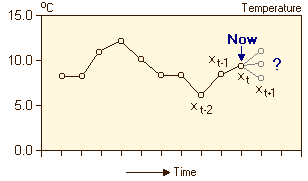 You are working with the text-only light edition of "H.Lohninger: Teach/Me Data Analysis, Springer-Verlag, Berlin-New York-Tokyo, 1999. ISBN 3-540-14743-8". Click here for further information.
You are working with the text-only light edition of "H.Lohninger: Teach/Me Data Analysis, Springer-Verlag, Berlin-New York-Tokyo, 1999. ISBN 3-540-14743-8". Click here for further information.
 You are working with the text-only light edition of "H.Lohninger: Teach/Me Data Analysis, Springer-Verlag, Berlin-New York-Tokyo, 1999. ISBN 3-540-14743-8". Click here for further information. You are working with the text-only light edition of "H.Lohninger: Teach/Me Data Analysis, Springer-Verlag, Berlin-New York-Tokyo, 1999. ISBN 3-540-14743-8". Click here for further information.
|
| See also: introduction, trends, model finding |   |
One major application of time series is to set up a model in order to
forecast data. The basic theory behind forecasting is to extract the information
contained in the time series and use this information to estimate the next
value(s). Information typically contained in a time series is based on:
As an introduction to forecasting, let us have a look at the following
example which is taken from a time series of air tempartures on subsequent
days at 8 am:

What could be the next data point of this time series. Why is it reasonable to estimate that x(t+1) will be 8, 9, or 10 °C? Maybe even 11°C? Why is it unlikely that the next morning temperature will be -2 °C ? How did you estimate x(t+1)?
A simple guess can be made by looking at x(t): The temperature tomorrow is likely to be close to that of today. In this case, we can assume that the estimation x(t+1) for tomorrow's value x(t+1) equals x(t):
x(t+1) := x(t) .
This is a useful formula for forecasting future time series values. It actually provides very good forecasts in most real world environments. Therefore, all results obtained with other methods should (at least) be compared to that obtained with this simple method.
And how did you guess the temperature two days ahead? Why is it more difficult to forecast x(t+2)? Because the deviation from x(t) may be larger. Usually, forecasting multiple time steps ahead is more difficult than forecasting a single time step ahead. Two approaches can be distinguished: x(t+2) can be forecast directly from x(t-m)...x(t). In this case, it is analogous to forecasting x(t+1). But x(t+2) can also be forecast after estimating x(t+1), taking this estimate into account. This step-wise forecasting technique is dangerous, as small errors may accumulate. Directly estimating x(t+2) is more advisable.
Back to x(t+1): How did you acutally come up with this forecast?
Apart from looking at x(t), it is also reasonable to take x(t-1) and x(t-2) into account. Since there is an upward tendency from 6 to 8 to 9°C, you may have guessed that x(t+1) will be 10, or 11°C. How can this process be automated? Basically, a model describing these dependencies is required. Therefore, when trying to forecast, the overall aim is to set up models for estimating future time series elements from past ones.
Last Update: 2004-Jul-03